Botox - wrinkles
How it works
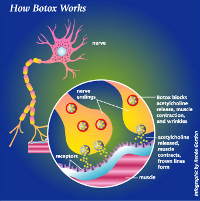
Botulinum Toxin - is the most acute natural toxin, causing blocking the release of acetylcholine - neurotransmitter responsible for sending the impulses between nerves and muscles. Botox works by blocking the junction where the nerve cells meet the muscle cells - named neuromuscular synapses. The toxin binds with the presynaptic membrane of the motor end-plate and blocks the release of acetylcholine. That makes the muscles relax and the wrinkles soften for some time. The process has been widely used in medicine.
Botulinum Toxin is currently used in the treatment of strabismus (crossed eyes), neurological disorders involving excessive tension of muscles, as well as in hyperhidrosis (excessive sweating) and reduction of mimic wrinkles. Administered as injections, it works locally, however, as muscle action gradually returns because the nerve fibres regenerate, the therapeutic effect of botox decreases after about 4-6 months. Then the procedure should be repeated.
Botulinum toxin is one of the strongest known biological toxin. It is a neurotoxin produced by the Clostridium botulinum anaerobic rod. There are 7 antigenic types of the toxin, classified from A to G. With people, poisoning occurs after consumption of canned commercial or home-canned foods, mainly with types A, B and E. For aesthetic purposes, the most commonly used pharmaceuticals of botulinum toxin type A are the following:
Botox® - produced by Allergan
Vistabel® - produced by Allergan (it is exactly Botox, placed in a single vial of 50 units of boltulinum toxin, while Botox® contains 100 of units in a single vial).
Azzalure® – produced by Galderma
Preparations of botulinum toxin applied in medicine are produced in laboratory conditions, from the isolated strains of bacteria, purified and then vacuum packed in strictly measured doses. Botulinum toxin is safely and successfully used in many fields of medicine.
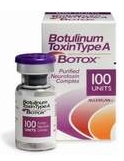 In aesthetic dermatology, to soften wrinkles, Botox® is administered with doses of 20-60 units during one procedure. It is therefore applied in very small, individually matched doses, which work only at the site of injection. Systemic toxicity is impossible, as toxic doses for human equal form 2,5 to 3 thousands of units.
In aesthetic dermatology, to soften wrinkles, Botox® is administered with doses of 20-60 units during one procedure. It is therefore applied in very small, individually matched doses, which work only at the site of injection. Systemic toxicity is impossible, as toxic doses for human equal form 2,5 to 3 thousands of units.
Azzalure® consists of Speywood units. One Speywood unit is defined as the median lethal peritoneal dose in mice. It is impossible to convert the Azzalure® units into the units of Botox®.
The difference between those two preparations lies in different molecular weight (900 kDa-Botox and 500-kDa Azzalure), which affects the rate of diffusion of both toxins. The Azzalure product has greater diffusion and so it blocks a wider area of muscles, which, in comparison to Botox®, gives more visible effects. However, a definite disadvantage of Azzalure is lack of possibility to administer the preparation precisely, in the cases, where we want to inject a very little dose of pharmaceutical and relax just a small part of the muscle (e.g. lower eyelid, area around lips).
Indications
Botox preparations are intended for people, who want to get rid of the mimic wrinkles. These are lines which very often occur already in young patients, as they are closely related to facial expression. In the case of very deep and firmly established wrinkles, it may be necessary to complement the treatment by filling the wrinkles with hyaluronic acid. It is also possible to combine the treatment with other methods of face-lift.
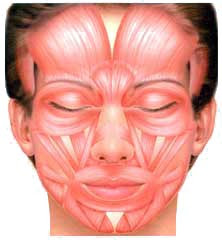 Botulinum toxin is widely used for eliminating the following types of wrinkles:
Botulinum toxin is widely used for eliminating the following types of wrinkles:
- lines between the eyebrows (so called lion's wrinkles in the glabellar area),
- transverse forehead wrinkles,
- wrinkles around the eyes (crow's feet),
- other: lower eyelid, around the lips, on the chin, neck;
In dermatology, apart from using botox for softening wrinkles, the treatment may be applied in case of excessive sweating of hands, feet and armpits. Botulinum toxin injections are also recommend to control muscle spasms and nervous tics, in cases of Cerebral Palsy Spasticity in children, in ophthalmology for strabismus (squints) and blepharospasm (excessive blinking) treatments. Botulinum toxin type A may also help us improve headache symptoms and quality of life - the toxin is then injected into certain forehead and neck areas to treat these chronic migraines.
The procedure
Botulinum toxin is injected using a disposable syringe with a very fine needle. A small amount of product is precisely injected into several sites of the face. The procedure doesn't last long. Depending on number of the treated areas (injection points), it takes about 15-20 minutes. Any pain associated with the injection is minimal. Many patients compare it to the impression of being bitten by an ant or mosquito. The procedure does not require local anaesthesia. Considering the patient's comfort, sometimes topical anaesthetic cream (EMLA) is recommended, about 1 hour before the procedure.
After the session
The wrinkles get totally or partially eliminated, the facial expression softens, looks naturally and stays preserved. The dose administered for cosmetic purposes is several times lower than the therapeutic dose and it is completely safe. It is adjusted based on individual patient's response.
The effects are visible already after 2-3 days after the injection, while full therapeutic effect is visible after 7-10 days. The treatment effect lasts, on average, for about 3-6 months. It depends on predispositions of individual organism.
After this period, the facial expression gradually returns. Upon complete termination of botox action, the procedure should be repeated. However, even if the patients cannot take follow up botox injections for various reasons, their skin condition stays visibly improved. The face, just after single botox treatment - meaning after a 6 month period of the toxin's action, looks younger and feels more relaxed. It happens many times, that the facial lines become shallower. It is possible thanks to additional action of botulinum toxin; when we do not perform any movements of the forehead muscles or the movements responsible for the 'crow's feet', our skin relaxes, and consequently, after that period it looks younger anyway. In this way, we make an investment for the future, offering our skin 6 months of rest.
Botulinum toxin therapy for aesthetic purposes is relatively simple. It is administered as an outpatient procedure, does not require any particular diagnostic tests and immediately after the session, the patients can return to their daily activities.
Contraindications
1) absolute:
- neuromuscular transmission disorders (myasthenia gravis, Lambert Eaton syndrome)
- hypersensitivity to any of the formula ingredients (human albumin)
- use of the following medicines or interval of up to one week after their withdrawal:
-aminoglycosides (streptomycin, gentamicin, amikacin, kanamycin, etc.)
-aminoquinolines (chloroquine, hydroxychloroquine)
-D-penicillamine (Cuprenil)
-cyclosporine
-tubocurarine, pancuronium, gallamine
-succinylcholine
-lincomycin, tetracycline, polymyxin
- local infection of the skin
- pregnancy, lactation
2) relative:
- coagulation disorders
- use of anticoagulative medicines (e.g. aspirin)
Adverse effects
- pain upon injection,
- small hematomas that may appear at the injection site, if the needle hits a small blood vessel,
- excessive brow drop or lift after the treatment of forehead wrinkles,
- little, temporary swelling with a feeling of tingling at the injection site,
- excessive muscle weakness near where the medicine was injected (eyelid dropping, mouth corner dropping),
- headache, going away after the application of analgesic;
Note: Botox side effects are mild and temporary for the most part, and usually go way on their own after a few days. The effect of excessive muscle relaxation may last from 2-6 weeks.
There is no risk of scars or other damage to the skin, and there are no marks left at the site of injection. The risk of adverse effects depends on the muscle which is injected and it should be discussed with your doctor before the treatment.
After the procedure
- within 0.5-1 hour, exercise your treated muscles of the injection site,
- restrain from massaging the botox injection areas,
- within 4 hours after the procedure, do not bend your head (e.g. while tying shoes or sleeping),
- avoid drinking alcohol or smoking up to 24 hours after the procedure (this weakens the action of botulinum toxin),
- avoid changes in atmospheric pressure (flying a plane, diving) for 24 hours after the procedure;
Is botulinum toxin only for women?
Botulinum toxin gives equally good effects in both men and women. In practice, more and more men are turning to botox to stay looking younger. The effectiveness of the worry lines removal makes this method popular among many business executives, providing them the freshness and increasing their accessibility, e.g. during business negotiations.
Follow-up treatments
The procedure may be repeated every 6-8 months, yet, no sooner than every 3 months. It is one of those treatments, for which patients return eagerly, because it brings immediate and long-lasting effects, which are noticed by everybody around and, at the same time, it is a non-invasive and easily performed treatment.
Examples of treatment effects: botox
A woman trying to bring forth "crow's feet"
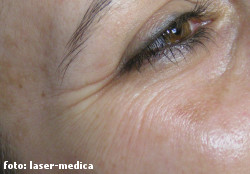 before |
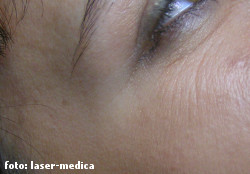 after |
A woman trying to bring forth "crow's feet"::
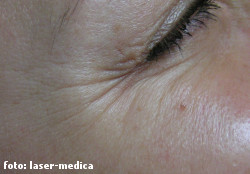 before |
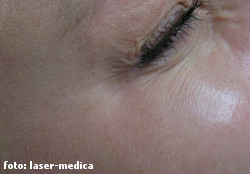 after |
A woman trying to frown:
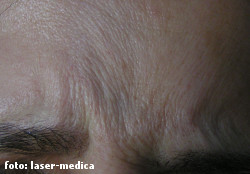 before |
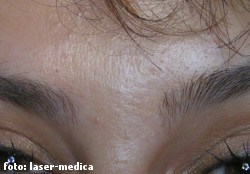 after |
A men trying to wrinkle his forehead
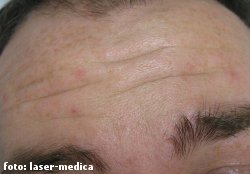 before |
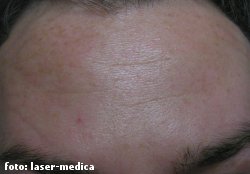 after |
*Copying and spreading of the photos without the consent of the owner is prohibited!!!

